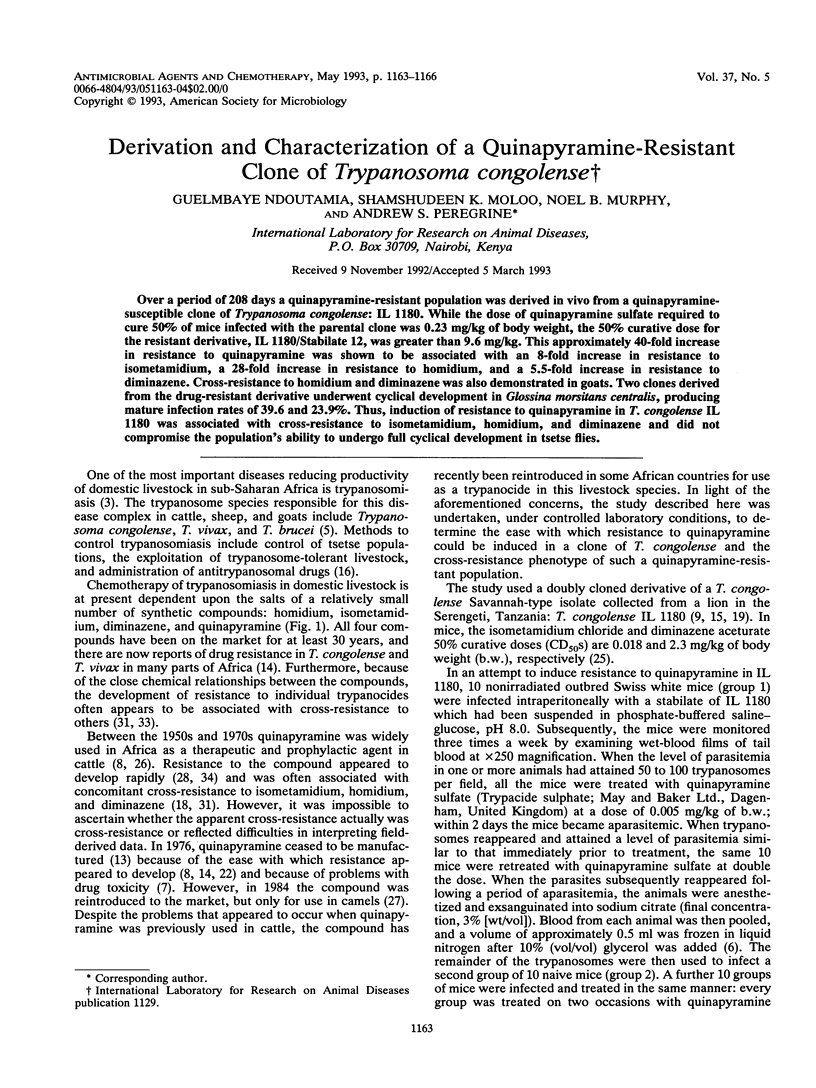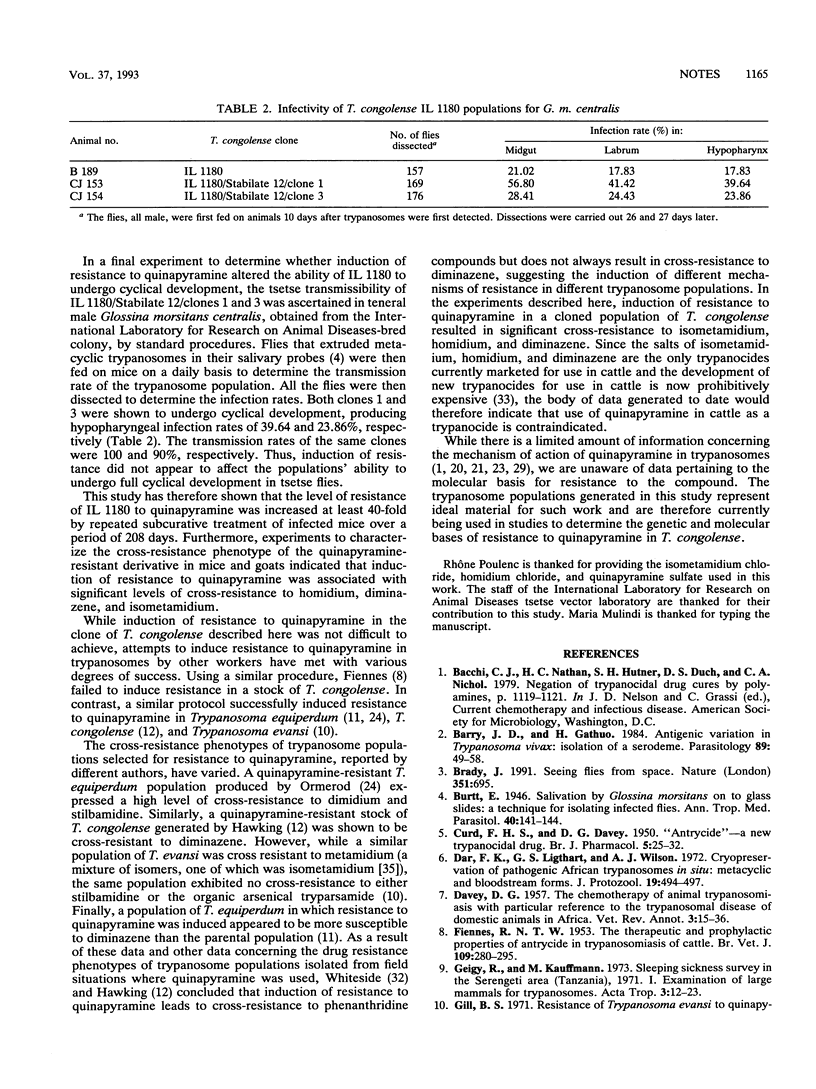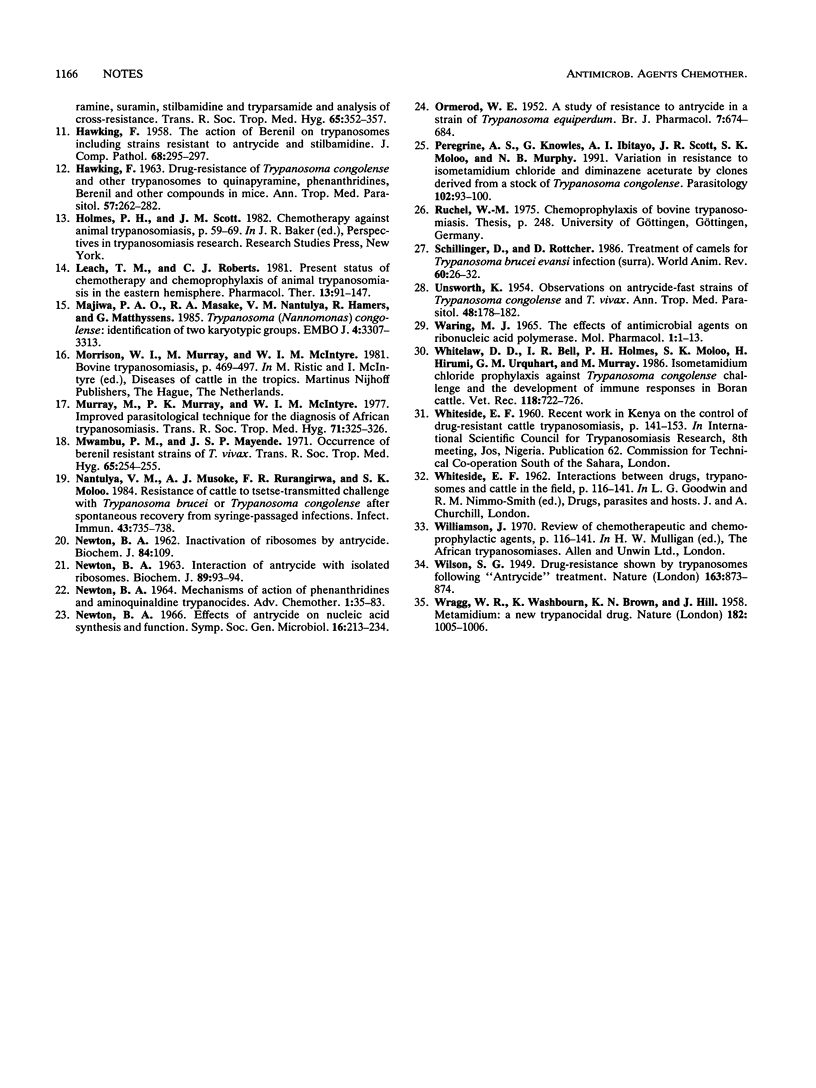Abstract
Over a period of 208 days a quinapyramine-resistant population was derived in vivo from a quinapyramine-susceptible clone of Trypanosoma congolense: IL 1180. While the dose of quinapyramine sulfate required to cure 50% of mice infected with the parental clone was 0.23 mg/kg of body weight, the 50% curative dose for the resistant derivative, IL 1180/Stabilate 12, was greater than 9.6 mg/kg. This approximately 40-fold increase in resistance to quinapyramine was shown to be associated with an 8-fold increase in resistance to isometamidium, a 28-fold increase in resistance to homidium, and a 5.5-fold increase in resistance to diminazene. Cross-resistance to homidium and diminazene was also demonstrated in goats. Two clones derived from the drug-resistant derivative underwent cyclical development in Glossina morsitans centralis, producing mature infection rates of 39.6 and 23.9%. Thus, induction of resistance to quinapyramine in T. congolense IL 1180 was associated with cross-resistance to isometamidium, homidium, and diminazene and did not compromise the population's ability to undergo full cyclical development in tsetse flies.
Full text
PDF



Selected References
These references are in PubMed. This may not be the complete list of references from this article.
- Barry J. D., Gathuo H. Antigenic variation in Trypanosoma vivax: isolation of a serodeme. Parasitology. 1984 Aug;89(Pt 1):49–58. doi: 10.1017/s0031182000001128. [DOI] [PubMed] [Google Scholar]
- CURD F. H. S., DAVEY D. G. Antrycide, a new trypanocidal drug. Br J Pharmacol Chemother. 1950 Mar;5(1):25–32. doi: 10.1111/j.1476-5381.1950.tb00573.x. [DOI] [PMC free article] [PubMed] [Google Scholar]
- Dar F. K., Ligthart G. S., Wilson A. J. Cryopreservation of pathogenic African trypanosomes in situ: metacyclic and bloodstream forms. J Protozool. 1972 Aug;19(3):494–497. doi: 10.1111/j.1550-7408.1972.tb03511.x. [DOI] [PubMed] [Google Scholar]
- Geigy R., Kauffmann M. Sleeping sickness survey in the Serengeti area (Tanzania) 1971. I. Examination of large mammals for trypanosomes. Acta Trop. 1973;30(1):12–23. [PubMed] [Google Scholar]
- HAWKING F. DRUG-RESISTANCE OF TRYPANOSOMA CONGOLENSE AND OTHER TRYPANOSOMES TO QUINAPYRAMINE, PHENANTHRIDINES, BERENIL AND OTHER COMPOUNDS IN MICE. Ann Trop Med Parasitol. 1963 Sep;57:262–282. doi: 10.1080/00034983.1963.11686181. [DOI] [PubMed] [Google Scholar]
- HAWKING F. The action of berenil on trypanosomes, including strains resistant to antrycide and to stilbamidine. J Comp Pathol. 1958 Jul;68(3):295–299. doi: 10.1016/s0368-1742(58)80030-2. [DOI] [PubMed] [Google Scholar]
- Leach T. M., Roberts C. J. Present status of chemotherapy and chemoprophylaxis of animal trypanosomiasis in the Eastern hemisphere. Pharmacol Ther. 1981;13(1):91–147. doi: 10.1016/0163-7258(81)90069-3. [DOI] [PubMed] [Google Scholar]
- Majiwa P. A., Masake R. A., Nantulya V. M., Hamers R., Matthyssens G. Trypanosoma (Nannomonas) congolense: identification of two karyotypic groups. EMBO J. 1985 Dec 1;4(12):3307–3313. doi: 10.1002/j.1460-2075.1985.tb04081.x. [DOI] [PMC free article] [PubMed] [Google Scholar]
- Murray M., Murray P. K., McIntyre W. I. An improved parasitological technique for the diagnosis of African trypanosomiasis. Trans R Soc Trop Med Hyg. 1977;71(4):325–326. doi: 10.1016/0035-9203(77)90110-9. [DOI] [PubMed] [Google Scholar]
- NEWTON B. A. MECHANISMS OF ACTION OF PHENANTHRIDINE AND AMINOQUINALDINE TRYPANOCIDES. Adv Chemother. 1964;25:35–83. doi: 10.1016/b978-1-4831-9929-0.50008-5. [DOI] [PubMed] [Google Scholar]
- Nantulya V. M., Musoke A. J., Rurangirwa F. R., Moloo S. K. Resistance of cattle to tsetse-transmitted challenge with Trypanosoma brucei or Trypanosoma congolense after spontaneous recovery from syringe-passaged infections. Infect Immun. 1984 Feb;43(2):735–738. doi: 10.1128/iai.43.2.735-738.1984. [DOI] [PMC free article] [PubMed] [Google Scholar]
- ORMEROD W. E. A study of resistance to antrycide in a strain of Trypanosoma equiperdum. Br J Pharmacol Chemother. 1952 Dec;7(4):674–684. doi: 10.1111/j.1476-5381.1952.tb00737.x. [DOI] [PMC free article] [PubMed] [Google Scholar]
- Peregrine A. S., Knowles G., Ibitayo A. I., Scott J. R., Moloo S. K., Murphy N. B. Variation in resistance to isometamidium chloride and diminazene aceturate by clones derived from a stock of Trypanosoma congolense. Parasitology. 1991 Feb;102(Pt 1):93–100. doi: 10.1017/s0031182000060388. [DOI] [PubMed] [Google Scholar]
- UNSWORTH K. Observations on antrycide, fast strains of Trypanosoma congolense and T. vivax. Ann Trop Med Parasitol. 1954 Jun;48(2):178–182. doi: 10.1080/00034983.1954.11685613. [DOI] [PubMed] [Google Scholar]
- WRAGG W. R., WASHBOURN K., BROWN K. N., HILL J. Metamidium: a new trypanocidal drug. Nature. 1958 Oct 11;182(4641):1005–1006. doi: 10.1038/1821005a0. [DOI] [PubMed] [Google Scholar]
- Waring M. J. The effects of antimicrobial agents on ribonucleic acid polymerase. Mol Pharmacol. 1965 Jul;1(1):1–13. [PubMed] [Google Scholar]
- Whitelaw D. D., Bell I. R., Holmes P. H., Moloo S. K., Hirumi H., Urquhart G. M., Murray M. Isometamidium chloride prophylaxis against Trypanosoma congolense challenge and the development of immune responses in Boran cattle. Vet Rec. 1986 Jun 28;118(26):722–726. doi: 10.1136/vr.118.26.722. [DOI] [PubMed] [Google Scholar]


